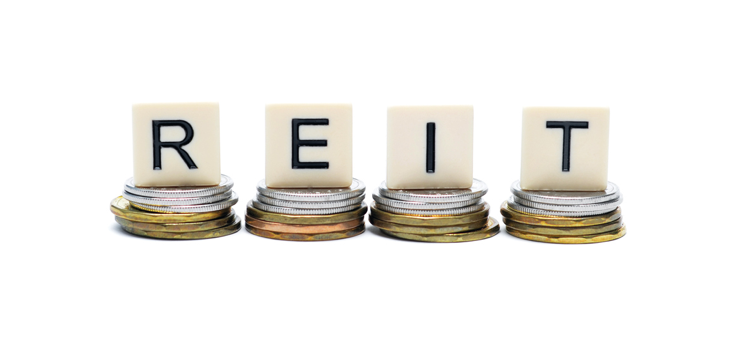When researching the various ways to invest in real estate, an investor is often faced with the choice of directly owning a property versus buying shares of a REIT. While both investment options may offer the opportunity for recurring income, they do so in different ways.
In this article, we’ll discuss some of the benefits and drawbacks to investing in REITs vs real estate, to help you better understand which option might be best.
Key takeaways
- Physical real estate means directly owning property such as a single-family rental home, multifamily building, or commercial property.
- A REIT is a company that owns and operates real estate, and rather than directly purchasing a property, an investor buys shares of a REIT.
- Benefits of physical real estate include potential rental income, gain in property value from appreciation, and tax benefits to reduce taxable net income.
- Some drawbacks to physical real estate are a sizable down payment needed to finance a property and lack of liquidity.
- Potential benefits of REITs may include minimal capital required to purchase a REIT share and the ease of buying and selling online.
- Two drawbacks to a REIT are lack of control of the underlying property, and for some investors, less pride of ownership.
Investing in physical real estate
Physical real estate includes traditional investments such as single-family rental homes, small multifamily buildings, condos and apartments, and commercial property like office buildings and shopping centers.
People hope to make money from physical real estate through rental income, appreciation in property value over the long term, and tax benefits such as using depreciation to reduce taxable net income.
An investor may own physical real estate individually, or by partnering with other investors. When an investor directly owns real estate, the property may be purchased and held for the long term, or fixed and flipped for a potential profit.
Benefits of investing in physical real estate
There are several potential advantages to owning physical real estate for an investor who has the time and capital available:
- Cash flow from rental income: Generating regular cash flow from monthly rental income is arguably the biggest potential advantage of owning real estate directly. Over time, an investor may generate multiple income streams by owning a number of rental properties.
- Asset appreciation over the long term: In addition to rental income, a buy-and-hold investor aims to make an additional profit when a property appreciates in value. Although real estate markets can go down as well as up, the median sales price of houses sold historically increases in value, according to this chart from the Federal Reserve.
- Tax deductions and benefits: Another reason investors directly own real estate is for the tax benefits used to reduce taxable net income and capital gains tax. Operating expenses such as property management and leasing fees, repairs and maintenance, mortgage interest and insurance, and property taxes may be deducted from rental income.
An investor may also deduct owner expenses such as continuing education or periodically traveling to an out-of-state property. Depreciation expense can be used to reduce pre-tax income, and a 1031 exchange allows an investor to defer paying capital gains tax when a rental property is sold and another one is purchased.
- Using leverage to purchase a property: An investor can use leverage or other people’s month to directly control a rental property by making a small down payment. For example, even though an investor makes a 25% down payment on a rental property, the investor has 100% of the rental income and 100% of any appreciation. Ideally, rental income from a property will generate enough money to pay for the mortgage and operating expenses, and still have positive cash flow left over at the end of each period.
- Direct control over the property: Directly owning physical real estate also allows for value add projects such as adding a bedroom to increase rentable square footage. An investor may also decide what renovations to make and when, and screen for the best possible tenants who will take care of the home and hopefully renew their lease year after year.
Drawbacks to investing in physical real estate
Despite the potential advantages, there are a lot of moving parts to manage to make a direct real estate investment profitable. An investor who owns physical real estate is ultimately responsible both personally and financially if a property is poorly managed or an investment loses money.
- Extensive research and analysis: Directly owning real estate requires time, research, and expertise to choose a good possible investment. An investor must accurately forecast factors such as occupancy levels and rent growth, operating expenses and future capital repairs and updates, and understand local and state landlord-tenant and federal fair housing laws. While a passive real estate investor may choose to delegate many of these tasks, an investor must still know enough to manage a real estate team.
- Large capital investment: Owning physical real estate is capital intensive due to the down payment amount and potential capital improvements. Generally speaking, an investor must make a down payment of at least 25% on a rental property loan. So, if a single-family rental home costs $100,000, the down payment will be $25,000 plus closing costs. Real estate is also a depreciation asset, and needs to be regularly maintained. An investor may also be required to make capital improvements such as replacing a heating and cooling system to keep a home habitable for a tenant.
- Property management intensive: Although real estate is often called a “passive” investment, directly owning a rental property can actually be a very active activity. Between marketing a vacant property for lease, screening a tenant and signing a lease, dealing with a tenant, and coordinating repairs with service people, directly owning real estate can seem like a full-time job. Even when an investor hires a property manager, financial performance reports need to be reviewed and the manager still needs to be monitored.
- Liability risk if something goes wrong: Directly owning real estate means that the buck stops with an investor. There may be the risk of financing default if a property sits vacant for an extended period of time and cash flow turns negative, or possible personal liability in the event of a lawsuit.
- Illiquid investment: Physical real estate can take a long time to buy and sell, even in today’s active markets. If an investor needs to raise cash in an emergency, a property may need to be priced below fair market value in order to attract a buyer who will pay in cash and close fast.

Investing in REITs
A REIT offers an investor a way to bypass some of the risks of owning real estate directly. Also known as a real estate investment trust, a REIT is a private or publicly held company that owns and operates various types of income-producing real estate.
Instead of buying physical real estate, an investor purchases shares of a REIT, similar to buying any other stock or mutual fund. While there are some advantages to investing in a REIT, such as minimal capital and the opportunity for recurring dividends, there are also some disadvantages to REITs as well.
Benefits of investing in REITs
- Recurring cash flow through dividend distributions: REITs are required by law to distribute at least 90% of their income as dividends to investors. According to a recent post on Yahoo, the best REIT stocks with high dividends have annual yields of 5.2% or more.
- Easy to buy with minimal investment required: Purchasing shares of a REIT works the same way as buying shares of any other stocks, including ETFs or mutual funds. Online stock trading platforms like Robinhood and Interactive Brokers also allow an investor to purchase fractional shares rather than an entire share.
- Diversification is much easier: Because much less capital is required, diversifying investments can be much easier with REITs. For example, an investor may choose to purchase shares in a REIT that owns real estate internationally, or REITs that focus on specific real estate asset classes, such as build-to-rent single-family homes or cold storage properties.
- Less investment expertise required: Another benefit of buying a REIT is simplicity. A REIT may allow an investor to enjoy a pro rata share of rental income and appreciation without being directly involved with managing a rental property or working with a property manager.
- REITs can be highly liquid: Selling shares in a publicly-traded REIT can be done in a few seconds with one click of a button, instead of waiting weeks or months to sell physical real estate. An investor who may need to raise cash quickly can sell such a REIT without having to deal with a real estate agent, closing costs, or calculating depreciation recapture.
Drawbacks to investing in REITs
- No tax benefits compared to directly owning a rental property: While an investor who physically owns real estate may benefit from tax deductions such as mortgage interest and depreciation expense to reduce taxable net income, REITs don’t offer the same tax breaks. Instead, dividend income from a REIT is taxed based on an investor’s total taxable income and filing status.
- Less opportunity for leverage and growth: Because REITs are required to distribute 90% of their profits to investors, only 10% is left over to reinvest in additional properties and grow a company. As a result, REIT shares prices may increase less than publicly-traded companies that reinvest their excess cash instead of paying dividends.
- Lack of direct control in underlying assets: Some investors may feel that owning a REIT doesn’t provide the same pride of ownership that owning physical real estate does. While an investor can periodically visit a rental property and have lunch with the property manager, it can be much more difficult to visit properties that a REIT actually owns.
- Potential for stock market volatility: Although REITs have a low correlation to the broad stock market, according to Nareit, there may still be the possibility of a sell-off if the overall stock market drops. On the other hand, single-family rentals offer a strong investment alternative to stocks and bonds, with much less volatility.
REITs vs physical real estate: How to choose?
There are distinct advantages to both REITs and real estate, but there’s no law that says an investor can’t own both. REITs require much less capital to invest in, can be easily traded like a stock, and may be a good way to diversify an investment portfolio. On the other hand, owning physical real estate like a single-family rental property provides numerous tax advantages, and allows an investor to potentially profit from rental income and the increase in property value over the long term.










